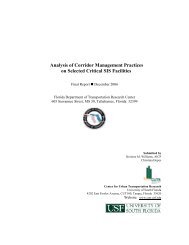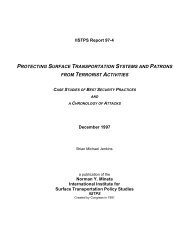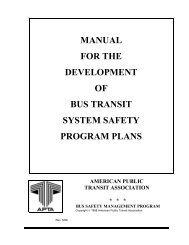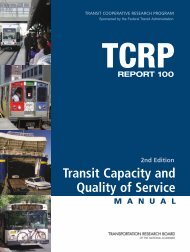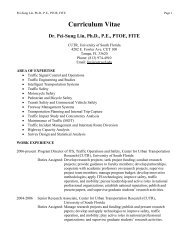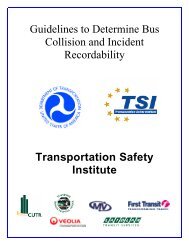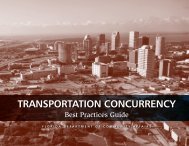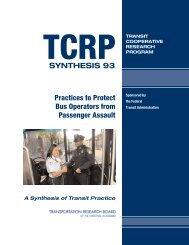a technical guide for conducting pedestrian safety assessments
a technical guide for conducting pedestrian safety assessments
a technical guide for conducting pedestrian safety assessments
You also want an ePaper? Increase the reach of your titles
YUMPU automatically turns print PDFs into web optimized ePapers that Google loves.
UNIVERSITY OF CALIFORNIA BERKELEY • INSTITUTE OF TRANSPORTATION STUDIES • TECHNOLOGY TRANSFER PROGRAM<br />
47<br />
A. STREETS<br />
Master Prompt<br />
Detailed Prompt<br />
A.1 Presence, Design,<br />
and Placement<br />
A.2 Quality, Conditions,<br />
and Obstructions<br />
A.1.1<br />
A.1.2<br />
A.1.3<br />
A.1.4<br />
A.1.5<br />
A.1.6<br />
A.1.7<br />
A.2.1<br />
A.2.2<br />
A.2.3<br />
Are sidewalks provided along the street?<br />
If no sidewalk is present, is there a walkable shoulder (e.g. wide<br />
enough to accommodate cyclists/<strong>pedestrian</strong>s) on the road or there<br />
pathway/trail nearby?<br />
Are shoulder/sidewalks provided on both sides of bridges?<br />
Is the sidewalk width adequate <strong>for</strong> <strong>pedestrian</strong> volumes?<br />
Is there adequate separation distance between vehicular traffic and<br />
<strong>pedestrian</strong>s?<br />
Are sidewalk/street boundaries discernable to people with visual<br />
impairments?<br />
Are ramps provided as an alternative to stairs?<br />
Will snow storage disrupt <strong>pedestrian</strong> access or visibility?<br />
Is the path clear from both temporary and permanent obstructions?<br />
Is the walking surface adequate and well maintained?<br />
A.3 Continuity and<br />
Connectivity<br />
A.4 Lighting<br />
A.5 Visibility<br />
A.6 Driveways<br />
A.7 Traffic Characteristics<br />
A.8 Signals, Signs and<br />
Pavement Markings<br />
A.9 Pedestrian Push<br />
Buttons and Signals<br />
A.3.1<br />
A.3.2<br />
A.4.1<br />
A.4.2<br />
A.5.1<br />
A.6.1<br />
A.6.2<br />
A.7.1<br />
A.8.1<br />
A.8.2<br />
A.9.1<br />
Are sidewalks/walkable shoulders continuous and on both sides of<br />
the street?<br />
Are measures needed to direct <strong>pedestrian</strong>s to safe crossing points<br />
and <strong>pedestrian</strong> access ways?<br />
Is the sidewalk adequately lit?<br />
Does street lighting improve <strong>pedestrian</strong> visibility at night?<br />
Is the visibility of <strong>pedestrian</strong>s walking along the sidewalk/shoulder<br />
adequate?<br />
Are the conditions at driveways intersecting sidewalks endangering<br />
<strong>pedestrian</strong>s?<br />
Does the number of driveways make the route undesirable <strong>for</strong><br />
<strong>pedestrian</strong> travel?<br />
Are there any conflicts between bicycles and <strong>pedestrian</strong>s on side<br />
walks?<br />
Are <strong>pedestrian</strong> travel zones clearly delineated from other modes of<br />
traffic thought the use of striping, colored an/or textured pavement,<br />
signing, and other methods?<br />
Is the visibility of signs and pavement markings adequate during the<br />
day and night to both the <strong>pedestrian</strong> and motorists?<br />
Are the push buttons accessible to all <strong>pedestrian</strong>s? Are the<br />
Pedestrian Signals visible to all <strong>pedestrian</strong>s?<br />
adapted from FHWA Pedestrian Road Safety Audit Guidelines and Prompt Lists



